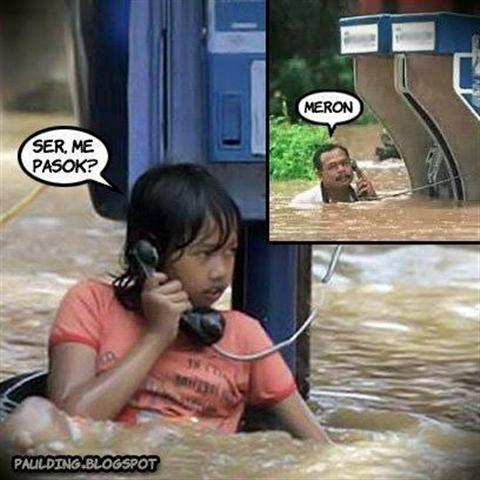On September 27, 2011 Typhoon Pedring hit land. It did not hit Metro Manila directly, yet, the rains that pour on the metropolis cause flooding in various places. The situation is worse in Central and Northern Luzon. All of a sudden we remember the floods brought by Typhoon Ondoy which wrecked havoc on Metro Manila, two years and one day ago.
The government was more prepared in 2011 compared to two years ago. Emergency workers evacuated river areas that are notorious for flooding. Authorities enforced forced evacuations to prevent casualties. And some residents acted more quickly this time to evacuate homes as waters rose. The weather bureau has forewarned the nation about the forthcoming scenario. Their regular updates have guided disaster management officials and the general public.
But still, some government offices that have not stepped up to the plate. The suspension of  classes at the college levels came at a time when most students have already gone to their colleges and universities. Likewise, the announcement that government employees not involved in emergency work do not have to report to their offices also came late in the morning Result: thousands of students and employees got stranded. The joke around town was that people were already swimming in the floods when they heard that classes and work were already suspended(see image).
classes at the college levels came at a time when most students have already gone to their colleges and universities. Likewise, the announcement that government employees not involved in emergency work do not have to report to their offices also came late in the morning Result: thousands of students and employees got stranded. The joke around town was that people were already swimming in the floods when they heard that classes and work were already suspended(see image).
There is also the question of why those in-charge of the dams have to wait for the water levels to reach almost spilling levels before they start releasing the waters. After all, the amount of rainfall hitting the various areas in the country has been measured and forecasted by Pagasa with a comfortable margin of accuracy.
In fairness, we have improved a lot in the disaster management side of the issue. But on the prevention side, much work needs to be done. Following are my reasons for making this conclusion:
- I am not sure if there is comprehensive plan to abate if not solve the flooding problem. And if ever there is one, I am not sure when it will be started. I have read a lot of press releases from several national government agencies and local governments on what they plan to do. But even the simple act of reforesting the Marikina watershed has not been started.
- There is no improvement in our garbage disposal system. Tons of garbage fill up the whole stretch of the shorelines of Manila Bay along Roxas Boulevard after every typhoon – trash that are from the esteros and canals upstream. Obviously, residents are still throwing their garbage directly into our waterways, and the government appears helpless in enforcing whatever law that prohibits throwing of garbage to the waterways.
- We have not relocated the squatters occupying waterways and floodways. Illegal residents continue to squat on easements and clog waterways with trash. Even middle to high income residents do not respect the easement laws. Just look at upscale and mid mid-scale subdivisions where residents appropriate public easements, either fencing them off or worse still, covering them over with permanent structures that clog waterways with concrete.
- We have not de-clogged our drainage and dredged our creeks and waterways. In fairness, there were so many projects aimed at de-clogging of canals and esteros immediately after Typhoon Ondoy. Two years after, however, these efforts have slowed down. A casual inspection all around the metropolis will show that many of our canals are still clogged with trash.
- We hardly maintain the dikes and sea walls separating bodies of waters from land. The breaching of dikes in Pampanga and Bulacan as well as the destruction of the sea wall along Roxas Boulevard attests to our failure to maintain these types of structures.
Given all the above, it is a foregone conclusion that floods will still be prevalent. Heavy rains will result in submerged streets and the best we can do is prepared for the floods. Following are simple reminders that will help anyone reduce the losses brought about by floods:
- Have an emergency plan and an emergency kit. Talk about an evacuation plan, what to do, where to meet, what things to have, and the contents of a grab and go bag in the event that calamities would happen. Make sure all members of the family, including household help are aware of this plan.
- Make sure you have an Act of God insurance coverage for your house and your car. This will protect your house, its contents, as well as provide coverage for lost rental income if you are renting your properties. The same goes for your car.
- Secure your important files and documents? Back-up your computer files and store it online. Scan important documents like land titles, passports, transcripts, diplomas, pictures, certificates, and pictures so that electronic copies can be stored safely in different secure locations or you can even store them online. Rent a safety deposit box in a bank located in a flood free area or invest in a fireproof and waterproof safe at home. Waterproof containers or plastic bags could also help protect documents against floods.
And one last suggestion. Pray for our safety.

